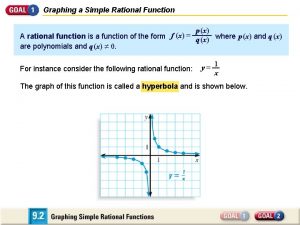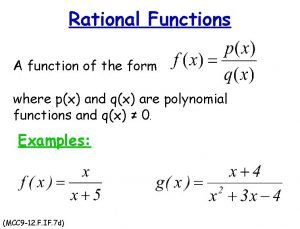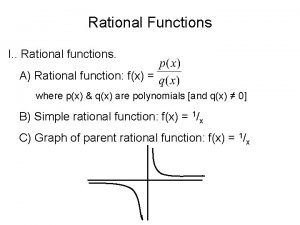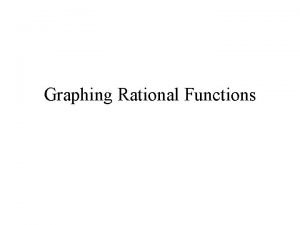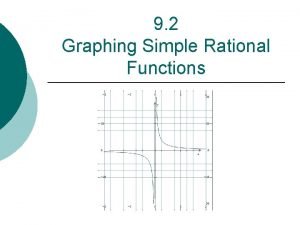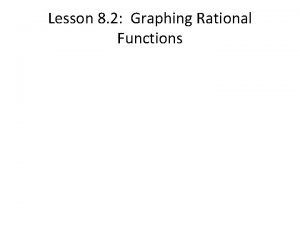Graphing Rational Functions A rational function is a












- Slides: 12

Graphing Rational Functions

A rational function is a function of the form f(x) = where P(x) and Q(x) are polynomials and Q(x) = 0. Example: f (x) = f(x) = , is defined for all real numbers except x = 0. x f(x) 2 0. 5 -2 -0. 5 1 1 -1 -1 0. 5 2 -0. 5 -2 0. 1 10 -0. 1 -10 0. 01 100 -0. 01 -100 0. 001 1000 -0. 001 -1000 As x → 0+, f(x) → +∞. As x → 0–, f(x) → -∞. 2

The line x = a is a vertical asymptote of the graph of y = f(x), if and only if f(x) → + ∞ or f(x) → – ∞ as x → a + or as x → a – f(x) → + ∞ as x → a – f(x) → – ∞ x x x=a as x → a + f(x) → + ∞ x=a x x=a as x → a + f(x) → – ∞ x x=a 3

Example: Show that the line x = 2 is a vertical asymptote of the graph of f(x) =. y x=2 x f(x) 1. 5 16 1. 9 400 1. 99 40000 2 - 2. 01 40000 2. 1 400 2. 5 16 Observe that: x→ 2–, f (x) → – ∞ x→ 2+, f (x) → + ∞ f (x) = 100 x 0. 5 This shows that x = 2 is a vertical asymptote. 4

A rational function may have a vertical asymptote at x = a for any value of a such that Q(a) = 0. Example: Find the vertical asymptotes of the graph of f(x) = . Set the denominator equal to zero and solve. Solve the quadratic equation x 2 + 4 x – 5. (x – 1)(x + 5) = 0 Therefore, x = 1 and x = -5 are the values of x for which f may have a vertical asymptote. As x → 1– , f(x) → – ∞. As x → -5–, f(x) → + ∞. As x → 1+, f(x) → + ∞. As x →-5+, f(x) → – ∞. x = 1 is a vertical asymptote. x = -5 is a vertical asymptote. 5

Example: Find the vertical asymptotes of the graph of f(x) = . 1. Find the roots of the denominator. 0 = x 2 – 4 = (x + 2)(x – 2) Possible vertical asymptotes are x = -2 and x = +2. 2. Calculate the values approaching -2 and +2 from both sides. x → -2, f(x) → -0. 25; so x = -2 is not a vertical asymptote. x → +2–, f(x) → – ∞ and x →+2+, f(x) → + ∞. y So, x = 2 is a vertical asymptote. x=2 f is undefined at -2 A hole in the graph of f at (-2, -0. 25) shows a removable singularity. (-2, -0. 25) x 6

The line y = b is a horizontal asymptote of the graph of y = f(x) if and only if f(x) → b + or f(x) → b – as x → + ∞ or as x → – ∞. as x → + ∞ f(x) → b – y as x → – ∞ f(x) → b – y y=b as x → + ∞ f(x) → b + y as x → – ∞ f(x) → b + y y=b y=b 7

Example: Show that the line y = 0 is a horizontal asymptote of the graph of the function f(x) =. As x becomes unbounded positively, f(x) approaches zero from above; therefore, the line y = 0 is a horizontal asymptote of the graph of f. As f(x) → – ∞, x → 0 –. x f(x) 10 0. 1 100 0. 01 1000 0. 001 0 – -10 -0. 1 -100 -0. 01 -1000 -0. 001 y f(x) = x y=0 8

Example: Determine the horizontal asymptotes of the graph of f(x) =. Divide x 2 + 1 into x 2. As x → +∞, f(x) = 1 – → 0– ; so, f(x) = 1 – Similarly, as x → – ∞, f(x) → 1–. Therefore, the graph of f has y = 1 as a horizontal asymptote. → 1 –. y y=1 x 9

Finding Asymptotes for Rational Functions Given a rational function: f (x) = P(x) Q(x) = am xm + lower degree terms bn xn + lower degree terms • If c is a real number which is a root of both P(x) and Q(x), then there is a removable singularity at c. • If c is a root of Q(x) but not a root of P(x), then x = c is a vertical asymptote. • If m > n, then there are no horizontal asymptotes. • If m < n, then y = 0 is a horizontal asymptote. • If m = n, then y = am is a horizontal asymptote. bn 10

Example: Find all horizontal and vertical asymptotes of f (x) = . Factor the numerator and denominator. The only root of the numerator is x = -1. The roots of the denominator are x = -1 and x = 2. x=2 Since -1 is a common root of both, there y is a hole in the graph at -1. Since 2 is a root of the denominator but not the numerator, x = 2 will be a vertical asymptote. y=3 x Since the polynomials have the same degree, y = 3 will be a horizontal asymptote. 11

A slant asymptote is an asymptote which is not vertical or horizontal. Example: Find the slant asymptote for f(x) =. Divide: x = -3 As x → + ∞, → 0+. As x → – ∞, → 0–. y y = 2 x - 5 x Therefore as x → ∞, f(x) is more like the line y = 2 x – 5. The slant asymptote is y = 2 x – 5. 12
 Rational function graph in real life
Rational function graph in real life Graphing rational functions cheat sheet
Graphing rational functions cheat sheet Graphing rational functions quiz
Graphing rational functions quiz Graphing rational functions
Graphing rational functions Graphing rational functions
Graphing rational functions 8-4 graphing rational functions
8-4 graphing rational functions Domain and range of rational function
Domain and range of rational function Rational function parent function
Rational function parent function Rational graph transformations
Rational graph transformations Logarithmic parent function domain and range
Logarithmic parent function domain and range Forms of rational functions
Forms of rational functions All real numbers graph
All real numbers graph Unit 5 homework 2 graphing polynomial functions
Unit 5 homework 2 graphing polynomial functions
